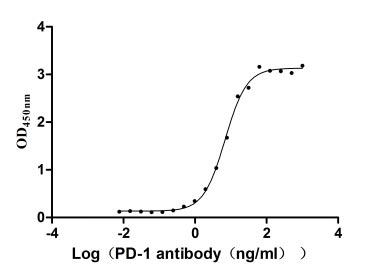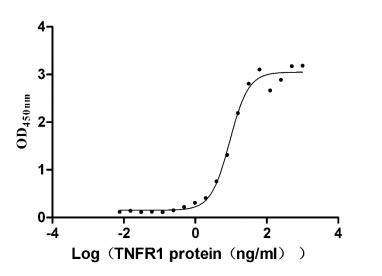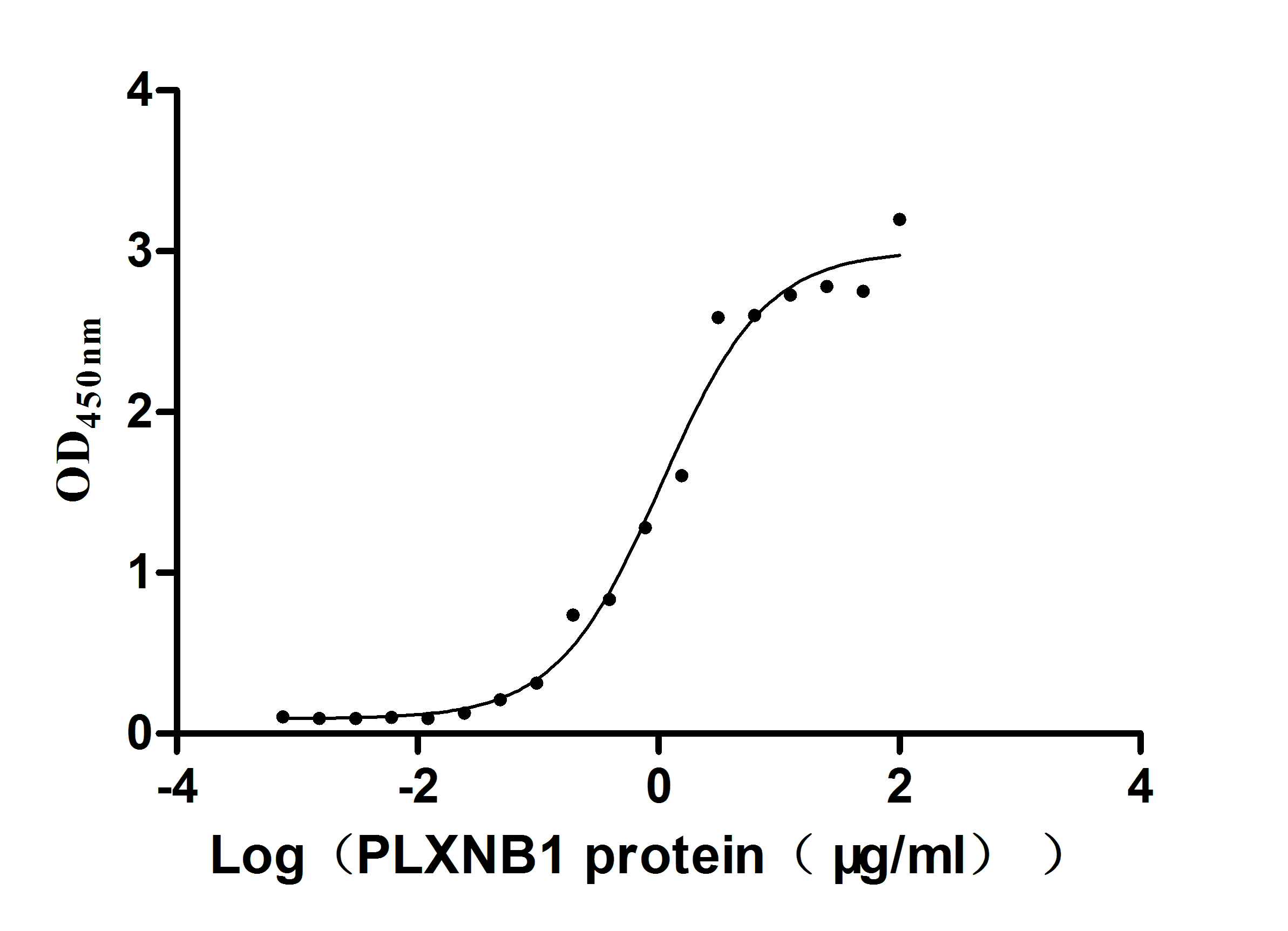Recombinant Mouse DNA-dependent protein kinase catalytic subunit (Prkdc), partial
-
货号:CSB-EP018714MO
-
规格:¥1836
-
图片:
-
其他:
产品详情
-
纯度:Greater than 90% as determined by SDS-PAGE.
-
基因名:
-
Uniprot No.:
-
别名:Prkdc; Xrcc7; DNA-dependent protein kinase catalytic subunit; DNA-PK catalytic subunit; DNA-PKcs; EC 2.7.11.1; p460
-
种属:Mus musculus (Mouse)
-
蛋白长度:Partial
-
来源:E.coli
-
分子量:34.6kDa
-
表达区域:3747-4015aa
-
氨基酸序列EYPFLVKGGEDLRQDQRIEQIFEVMNAILSQDAACSQRNMQLRTYRVVPMTSRLGLIEWIENTMTLKDLLLSNMSQEEKVANNSDPKAPIRDYKDWLMKVSGKSDAGAYVLMYSRANRTETVVAFRRRESQVPPDLLKRAFVKMSTSPEAFLALRSHFASSHALLCISHWLLGIGDRHLNNFMVAMETGSVIGIDFGHAFGSATQFLPVPELMPFRLTRQFVSLMLPMKETGLMCTVMVHALRAFRSCAGLLTDTMEIFVKEPSFDWKS
Note: The complete sequence including tag sequence, target protein sequence and linker sequence could be provided upon request. -
蛋白标签:N-terminal 6xHis-tagged
-
产品提供形式:Liquid or Lyophilized powder
Note: We will preferentially ship the format that we have in stock, however, if you have any special requirement for the format, please remark your requirement when placing the order, we will prepare according to your demand. -
缓冲液:Tris-based buffer,50% glycerol
-
储存条件:Store at -20°C/-80°C upon receipt, aliquoting is necessary for mutiple use. Avoid repeated freeze-thaw cycles.
-
保质期:The shelf life is related to many factors, storage state, buffer ingredients, storage temperature and the stability of the protein itself.
Generally, the shelf life of liquid form is 6 months at -20°C/-80°C. The shelf life of lyophilized form is 12 months at -20°C/-80°C. -
货期:Basically, we can dispatch the products out in 1-3 working days after receiving your orders. Delivery time may differ from different purchasing way or location, please kindly consult your local distributors for specific delivery time.Note: All of our proteins are default shipped with normal blue ice packs, if you request to ship with dry ice, please communicate with us in advance and extra fees will be charged.
-
注意事项:Repeated freezing and thawing is not recommended. Store working aliquots at 4°C for up to one week.
-
Datasheet & COA:Please contact us to get it.
相关产品
靶点详情
-
功能:Serine/threonine-protein kinase that acts as a molecular sensor for DNA damage. Involved in DNA non-homologous end joining (NHEJ) required for double-strand break (DSB) repair and V(D)J recombination. Must be bound to DNA to express its catalytic properties. Promotes processing of hairpin DNA structures in V(D)J recombination by activation of the hairpin endonuclease artemis (DCLRE1C). Recruited by XRCC5 and XRCC6 to DNA ends and is required to (1) protect and align broken ends of DNA, thereby preventing their degradation, (2) and sequester the DSB for repair by NHEJ. Act as a scaffold protein to aid the localization of DNA repair proteins to the site of damage. The assembly of the DNA-PK complex at DNA ends is also required for the NHEJ ligation step. Found at the ends of chromosomes, suggesting a further role in the maintenance of telomeric stability and the prevention of chromosomal end fusion. Also involved in modulation of transcription. As part of the DNA-PK complex, involved in the early steps of ribosome assembly by promoting the processing of precursor rRNA into mature 18S rRNA in the small-subunit processome. Binding to U3 small nucleolar RNA, recruits PRKDC and XRCC5/Ku86 to the small-subunit processome. Recognizes the substrate consensus sequence [ST]-Q. Phosphorylates 'Ser-139' of histone variant H2AX, thereby regulating DNA damage response mechanism. Phosphorylates DCLRE1C, c-Abl/ABL1, histone H1, HSPCA, c-jun/JUN, p53/TP53, PARP1, POU2F1, DHX9, FH, SRF, NHEJ1/XLF, XRCC1, XRCC4, XRCC5, XRCC6, WRN, MYC and RFA2. Can phosphorylate C1D not only in the presence of linear DNA but also in the presence of supercoiled DNA. Ability to phosphorylate p53/TP53 in the presence of supercoiled DNA is dependent on C1D. Contributes to the determination of the circadian period length by antagonizing phosphorylation of CRY1 'Ser-588' and increasing CRY1 protein stability, most likely through an indirect mechanism. Plays a role in the regulation of DNA virus-mediated innate immune response by assembling into the HDP-RNP complex, a complex that serves as a platform for IRF3 phosphorylation and subsequent innate immune response activation through the cGAS-STING pathway.
-
基因功能参考文献:
- findings identify a kinase-dependent role of DNA-PKcs in suppressing MH-mediated end joining and a structural role of DNA-PKcs protein in the orientation of class switch recombination. PMID: 30072430
- Loss of DNA-PKc expression is associated with impairment of non-homologous end-joining of radiation-induced double strand break repair in nasopharyngeal carcinoma. PMID: 29344644
- DNA repair, mediated by DNA-PK, and cell cycle arrest, mediated by p53, cooperate to protect the stem cell niche after DNA damage. PMID: 28686579
- Decreasing DNA-dependent protein kinase activity increases AMPK activity and prevents weight gain, decline of mitochondrial function, and decline of physical fitness in middle-aged mice and protects against type 2 diabetes. PMID: 28467930
- Ku70 is epistatic with XLF and DNA-PKcs and support a model in which inactivation of Ku70 allows DNA lesions to become accessible to alternative DNA repair pathways (other than Classical Non-Homologous End-Joining (C-NHEJ)). PMID: 28759779
- DNA-PKcs deficiency caused inefficient DSB repair at later time points post-IR in both conditions. These observations suggest that DNA-PKcs contributes to the fast and slow repair of DSBs by NHEJ. PMID: 27136939
- The SAGA deubiquitinase activity was required for optimal irradiation-induced gammaH2AX formation, and failure to remove H2BK120ub inhibits ATM- and DNAPK-induced gammaH2AX formation. PMID: 27160905
- functional DNA-PKcs T2609 cluster is required to facilitate telomere leading strand maturation and prevention of genomic instability and cancer development. PMID: 26616856
- TMU-35435 enhances etoposide cytotoxicity by regulating ubiquitin-proteasomal degradation of DNA-PKcs and inhibiting the DNA repair pathway in triple negative breast cancer cells. PMID: 28450160
- DNA-PKcs are required to prevent endogenous DNA damage accumulation throughout the adult brain. PMID: 28123024
- DNA-PK inhibition and siRNA-mediated DNA-PK knockdown blocked cell fusion in myoblasts which implicate a new role for DNA-PK in myogenic differentiation. PMID: 27513301
- protein deficiency impairs Ig class switch recombination PMID: 26546606
- AIM2 reduced Akt activation and tumor burden in colorectal cancer models, while an Akt inhibitor reduced tumor load in Aim2(-/-) mice PMID: 26107252
- PRKDC proteins that mediate non-homologous end joining have been identified as TRIP13 binding partners in head and neck cancer. PMID: 25078033
- NR5A1 prevents centriole splitting by inhibiting centrosomal DNA-PK activation and beta-catenin accumulation PMID: 25421435
- Results show that DNA-PKcs functions as a selective modulator of transcriptional networks that induce cell migration, invasion, and metastasis of prostate cancer cells. PMID: 26175416
- These experiments define a novel requirement for 53BP1 in the fusions of DNA-PKcs-deficient telomeres throughout the cell cycle. PMID: 25264618
- data suggest that DNA-PKcs-SIN1 complexation-mediated Akt activation (Ser-473 phosphorylation) is required for mouse osteoblast differentiation PMID: 25264192
- Activated platelets accumulate in the brain rescue apoptotic neuron cells via activation of EGFR and DNA-dependent protein kinase. PMID: 25210793
- DNA-PK and ATM acts in parallel upstream of XRCC4, regulating through phosphorylation PMID: 25391321
- DNA-PKcs is the molecular switch that coordinates end-processing and end-ligation at the DNAends through differential phosphorylations. PMID: 25818648
- DNA-PK/Chk2 signaling induces centrosome amplification upon long-term HU treatment, therefore increasing our insight into tumor recurrence after initial chemotherapy. PMID: 24662822
- DNA-PK is a DNA sensor for IRF-3-dependent innate immunity. PMID: 23251783
- A novel regulatory pathway where signaling from DNA-PK appears to suppress midbrain-specific Lmx1a expression. PMID: 24194952
- Inactivation of Ku80 and DNA-PKCS causes reduced lifespan and bodyweight. PMID: 24740260
- Thus SB and PB transposons represent a promising non-viral approach for iPS cell derivation. PMID: 24928388
- GANP plays a positive role in IgV region diversification of DT40 B cells in a nonhomologous end joining-proficient state. DNA-PKcs physically interacts with GANP, and this interaction is dissociated by dsDNA breaks PMID: 24808370
- IP7, formed by IP6K2, binds CK2 to enhance its phosphorylation of the Tti1/Tel2 complex, thereby stabilizing DNA-PKcs and ATM. This process stimulates p53 phosphorylation at serine 15 to activate the cell death program. PMID: 24657168
- the inhibition of DNA-PK-dependent DNA sensing by a poxvirus protein, adding to the evidence that DNA-PK is a critical component of innate immunity to DNA viruses. PMID: 24098118
- interaction between DNA-PKcs and Snail1 might be an effective strategy for sensitizing cancer cells and inhibiting tumor migration PMID: 24085291
- During V(D)J recombination, DNA-PKcs repairs coding DNA ends. DNA-PKcs deficiency leads to a nearly complete block in coding join formation, as DNA-PKcs is required to activate the endonuclease that opens hairpin-sealed coding ends. PMID: 23836881
- XLF functionally overlaps with DNA-PKcs in normal development, promotion of genomic stability in fibroblasts, and in IgH class switch recombination in mature B cells. PMID: 23345432
- DNA-PK is needed to generate the phosphorylated form of H2AX that controls necroptosis. PMID: 22972376
- our results suggest that DNA-PKcs may interact with Aire to promote the expression of Toll-like receptors in RAW264.7 cells. PMID: 22239103
- Lack of DNA-PKcs is accompanied by an increase in the protein level of one of the catalytic isozymes of protein kinase CK2, i.e., CK2alpha' and a concomitant increase in CK2 activity. PMID: 21750982
- RAD50, DNA-PKcs kinase activity, and transcription context are each important to limit incorrect end use during EJ repair of multiple DSBs, but each has distinct roles during repair events requiring end processing PMID: 22027841
- We concluded that phosphorylation of DNA-activated protein kinase catalystic subunit is essential for the normal activation of multiple DNA repair pathways, which in turn is critical for the maintenance of diverse populations of tissue stem cells in mice. PMID: 21482716
- Our results demonstrate that both Prkdc SNPs are responsible for deficient DNA-PKcs protein expression, DNA repair and telomere function, while the LEWES SNP affects only DNA-PKcs expression and repair capacity. PMID: 21265624
- DNA-PK is implicated in the repair of double-stranded DNA breaks during neurogenesis in the developing retina PMID: 20448641
- treatment of DNA-PKcs- or ATM-deficient cells, respectively, with specific kinase inhibitors for ATM or DNA-PKcs recapitulates SJ defects, indicating that overlapping V(D)J recombination functions of ATM and DNA-PKcs are mediated through kinase activities PMID: 21245310
- Atm and DNA-PKcs have overlapping catalytic activities that are required for chromosomal signal joint formation and for preventing the aberrant resolution of signal ends as potentially oncogenic chromosomal translocations PMID: 21245316
- Data implicate mtDNA damage in the development of adriamycin toxicity and identify Prkdc as a mtDNA depletion syndrome modifier gene and a component of the mitochondrial genome maintenance pathway. PMID: 20978358
- MiR-101 could efficiently target DNA-PKcs and ATM via binding to the 3'- UTR of DNA-PKcs or ATM mRNA. PMID: 20617180
- the nucleotide sequence of approximately 193-kbp and 84-kbp genomic regions encoding the entire Prkdc gene PMID: 11839092
- required for p53-dependent apoptosis in mouse embryo fibroblasts PMID: 12065413
- DNA-PK role in radioadaptive response of mouse spleen PMID: 12194752
- Generating mice doubly deficient in DNA-PKcs and telomerase (Terc(-/-)/DNA-PKcs(-/-))shows that DNA-PKcs also has a fundamental role in telomere length maintenance, suggesting suggest a critical role of DNA-PKcs in both cancer and aging. PMID: 12426399
- The function of DNA-dependent protein kinase catalytic subunit is retained in DNA-PKcs-deficient dendritic cells (DC) from knockout mice, therefore DNA-PKcs is not essential for DC responses to CpG DNA. PMID: 12626561
- Evidence is found that chromosome 16 segments from BALB/c that encode Prkdc interact with Apc(Min) (multiple intestinal neoplasia) and specifically enhance IR-induced adenoma development in the upper part of the small intestine. PMID: 12750251
- BALB/c alleles for Prkdc and Cdkn2a interact to modify mammary tumor susceptibility in Trp53+/- mice. PMID: 12750252
显示更多
收起更多
-
相关疾病:Defects in Prkdc are the cause of severe combined immune deficiency (SCID) which is characterized by a lack of mature functional lymphocytes and a high susceptibility to lethal opportunistic infections if not chronically treated with antibiotics. The lack of B- and T-cell immunity resembles severe combined immunodeficiency syndrome in human infants.
-
亚细胞定位:Nucleus. Nucleus, nucleolus.
-
蛋白家族:PI3/PI4-kinase family
-
数据库链接:
KEGG: mmu:19090
STRING: 10090.ENSMUSP00000023352
UniGene: Mm.71
Most popular with customers
-
Recombinant Human Programmed cell death protein 1 (PDCD1), partial (Active)
Express system: Mammalian cell
Species: Homo sapiens (Human)
-
Recombinant Human Tumor necrosis factor receptor superfamily member 1A (TNFRSF1A), partial (Active)
Express system: Mammalian cell
Species: Homo sapiens (Human)
-
Recombinant Human Plexin-B1 (PLXNB1), partial (Active)
Express system: Mammalian cell
Species: Homo sapiens (Human)
-
Recombinant Human Interleukin-17A (IL17A) (T26A) (Active)
Express system: Baculovirus
Species: Homo sapiens (Human)
-
Recombinant Human Cytotoxic and regulatory T-cell molecule (CRTAM), partial (Active)
Express system: Mammalian cell
Species: Homo sapiens (Human)
-
Recombinant Human Mucin-13(MUC13),partial (Active)
Express system: yeast
Species: Homo sapiens (Human)






-AC1.jpg)












